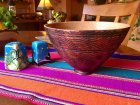I’ve been trying to use a propane torch to embellish maple bowls and platters and I’m having a heck of a time. On the first piece, a small plate, the wood warped like crazy. On my next piece, a bowl, I turned the outside and decided to burn it before hollowing. I thought that might limit the warping, but instead it developed some significant cracks. I went ahead and hollowed it anyway and think it looks OK, but it’s definitely not what I was going for.
Both blanks were many years old and completely dry. Anyone have any tips for successfully burning a bowl or platter? I found a YouTube video by Sam Angelo, but warping wasn’t even mentioned.
Thanks in advance.
Both blanks were many years old and completely dry. Anyone have any tips for successfully burning a bowl or platter? I found a YouTube video by Sam Angelo, but warping wasn’t even mentioned.
Thanks in advance.


